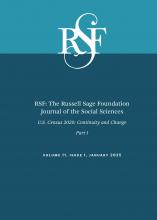Abstract
According to the U.S. Census, the multiracial population grew 276 percent between 2010 and 2020 and now represents 10.2 percent of the national population. Some believe that norms of hypodescent, which limited multiracial self-identification for most of U.S. history, are weakening. We explore two competing explanations: natural demographic growth and modifications in census methods and data processing. Through a cohort-level analysis of multiracial identification over time in the American Community Survey, we find that the multiracial population is growing naturally. However, most of the multiracial growth stems from changes in data processing enacted in 2020. Such changes doubled multiracial self-identification among the general population, which was fueled by a sevenfold increase among the Hispanic population. We confirm the absence of sharp cultural shifts in multiracial identification by examining data from the Current Population Survey, which did not implement data processing changes during this period, as a counterfactual data source.
- © 2025 Russell Sage Foundation. Ventura, Ilana M., and René D. Flores. 2025. “The ‘Rise’ of Multiracials? Examining the Growth in Multiracial Identification in the 2020 U.S. Census.” RSF: The Russell Sage Foundation Journal of the Social Sciences 11(1): 44–64. https://doi.org/10.7758/RSF.2025.11.1.03. Direct correspondence to: Ilana M. Ventura, at ventura-ilana{at}norc.org, NORC, 55 East Monroe St, 30th Floor, Chicago, IL 60603, United States.
Open Access Policy: RSF: The Russell Sage Foundation Journal of the Social Sciences is an open access journal. This article is published under a Creative Commons Attribution-NonCommercial-NoDerivs 3.0 Unported License.






